Multiple Precaching Vehicle Selection Scheme Based on Set Ranking in Intermittently Connected Vehicular Networks
Abstract
1. Introduction
2. Related Work
2.1. Content-Centric Vehicular Networks
2.2. V2I Precaching in CCVNs
2.2.1. Popularity-Based V2I Precaching in CCVNs
2.2.2. Mobility Prediction-Based V2I Precaching in CCVNs
2.3. V2V Precaching Using One Relaying Vehicle in CCVNs
2.4. V2V Precaching Using Relaying Vehicles in CCVNs
2.5. Contributions
- We considered all groups that could become a content-precaching vehicle group based on their ability to provide the requested content within the outage zone. We prioritized selecting groups containing fewer relaying vehicles to ensure a high success rate for content requests and improve the overall performance.
- We set the proportion of dwell time used to precache the requested content by each relaying vehicle in the selected group within the current RSU’s coverage. This was in contrast to existing V2V precaching schemes, wherein all the abundant dwell time of relaying vehicles was spent precaching, resulting in an inability to request or receive their own content. By controlling the proportion of dwell time used by each relaying vehicle, we improved the fairness of content request allocation.
- We designed a content request model to evaluate the proposed scheme. Each vehicle decided whether to request content at a given time according to Poisson distribution. When the vehicle decided to request content, the requested content was decided based on Zipf’s law. Then, the size of the content was decided based on Gaussian distribution.
- We designed a highway mobility model wherein vehicles traveled with acceleration and speed determined based on Gaussian distribution, reflecting a realistic highway scenario. We also considered a highway scenario that had no drastic directional changes, with all vehicles traveling on a straight road.
3. Network Model and Scheme Overview
3.1. Network Model
3.2. Scheme Overview
4. MPVS Scheme
4.1. Calculation of Content Downloading Amount
4.2. Calculation of Content-Precaching Amount
4.3. Selection of Content-Precaching Vehicle Group
4.4. Content Downloading through Content-Precaching Vehicle Group
5. Performance Evaluation
5.1. Simulation Environment
- Request success rate (%): A vehicle that is selected as a relaying vehicle cannot request or receive its own intended content because it spends its entire dwell time within the coverage area of the current RSU precaching the requested content for other requester vehicles. Therefore, the vehicle suffers a very long delay until it reaches the next RSU. To measure this request failure, we evaluated the request success rate, which is the ratio of the number of successful content requests to the total number of requests. It is directly related to user QoS and reliability because it affects delays. Thus, it is a critical factor for content delivery to vehicles in CCVNs.
- Precaching fairness (F): In the AMRS scheme, the relaying vehicle that has abundant dwell time spends all of its dwell time precaching, which is unfair to this vehicle. To measure the fairness for the selected relaying vehicles, we evaluated the precaching fairness based on Shannon’s diversity index as follows:Here, indicates the ratio of the precaching usage rate of the k–th relaying vehicle to the sum of each precaching usage rate as follows:and is calculated aswhere is the amount that the k–th relaying vehicle has to precache, and is the amount of content that the k–th relaying vehicle can receive within the coverage area of the current RSU. Since the number of vehicles selected as relaying vehicles was the same in each scheme, a large F indicated a high disorder of for each relaying vehicle. Furthermore, as the number of relaying vehicles increases, many vehicles have to spend their dwell time on the requests of other vehicles, causing F to decrease.
- Request decision period (s): The request decision period is a parameter that determines how often vehicles decide to request content, and it reflects the impact on performance as the number of requests from vehicles increases. Therefore, it reflects the performance according to the number of requester vehicles when the number of candidate vehicles is fixed. A shorter decision period means that vehicles make content request decisions more frequently, leading to an increase in the number of requester vehicles that an RSU has to select as relaying vehicles. As a result, the relaying vehicles may spend more of their dwell time on the requests of other vehicles, which can affect their ability to request their own content.
- Requested content size (GB): The requested content size is the average size of the requested content and indicates the number of candidate vehicles required. Therefore, it reflects the performance according to the number of candidate vehicles required when the number of requester vehicles is fixed. If the size of the requested content is too small, the precaching fairness is less affected by selecting a single relaying vehicle because it requires fewer candidate vehicles. As the size of the requested content increases, the selection of requester vehicles differs in each scheme. If the size of the requested content is too large, each requester vehicle employs a large number of candidate vehicles as relaying vehicles, resulting in a decrease in the request success rate.
- Vehicle density (/km): The vehicle density is the number of vehicles on a 1 km stretch of the straight road. Therefore, it reflects the performance when the number of candidate vehicles and the number of requester vehicles grow at the same rate. When the number of vehicles is small, fewer requester vehicles require fewer relaying vehicles, which means that other vehicles have a higher success rate in their requests; however, this comes at the expense of fewer candidate available vehicles, so it is not possible to select a better group. If the number of vehicles is large enough that a better group can be selected, the precaching fairness of the proposed scheme is improved. However, if the number of vehicles is too large, the number of requester vehicles increases, requiring a larger number of candidate vehicles, and the request success rate decreases. For example, if the number of requesting vehicles quadruples, more candidate vehicles are required because the best groups are exhausted and the next best group must be selected from the remaining candidate vehicles.
5.2. Simulation Results
6. Conclusions
Author Contributions
Funding
Institutional Review Board Statement
Informed Consent Statement
Data Availability Statement
Conflicts of Interest
References
- Shahwani, H.; Shah, S.A.; Ashraf, M.; Akram, M.; Jeong, J.; Shin, J. A comprehensive survey on data dissemination in Vehicular Ad Hoc Networks. Veh. Commun. 2021, 34, 100420. [Google Scholar] [CrossRef]
- Zhang, Z.; Lung, C.-H.; St-Hilaire, M.; Lambadaris, I. Smart Proactive Caching: Empower the Video Delivery for Autonomous Vehicles in ICN-Based Networks. IEEE Trans. Veh. Technol. 2020, 69, 7955–7965. [Google Scholar] [CrossRef]
- Yuan, Q.; Zhou, H.; Li, J.; Liu, Z.; Yang, F.; Shen, X.S. Toward Efficient Content Delivery for Automated Driving Services: An Edge Computing Solution. IEEE Netw. 2018, 32, 80–86. [Google Scholar] [CrossRef]
- Lee, M.; Atkison, T. VANET applications: Past, present, and future. Veh. Commun. 2021, 28, 100310. [Google Scholar] [CrossRef]
- Kim, D.; Velasco, Y.; Wang, W.; Uma, R.N.; Hussain, R.; Lee, S. A New Comprehensive RSU Installation Strategy for Cost-Efficient VANET Deployment. IEEE Trans. Veh. Technol. 2017, 66, 4200–4211. [Google Scholar] [CrossRef]
- Reis, A.B.; Sargento, S.; Neves, F.; Tonguz, O.K. Deploying Roadside Units in Sparse Vehicular Networks: What Really Works and What Does Not. IEEE Trans. Veh. Technol. 2014, 63, 2794–2806. [Google Scholar] [CrossRef]
- Kumar, V.; Mishra, S.; Chand, N. Applications of VANETs: Present & Future. Commun. Netw. 2013, 5, 12–15. [Google Scholar] [CrossRef]
- Singh, P.K.; Nandi, S.K.; Nandi, S. A tutorial survey on vehicular communication state of the art, and future research directions. Veh. Commun. 2019, 18, 100164. [Google Scholar] [CrossRef]
- Reichardt, D.; Miglietta, M.; Moretti, L.; Morsink, P.; Schulz, W. CarTALK 2000: Safe and comfortable driving based upon inter-vehicle-communication. Intell. Veh. Symp. IEEE 2002, 2, 545–550. [Google Scholar] [CrossRef]
- Yen, Y.-T.; Chou, J.-J.; Shih, C.-S.; Chen, C.-W.; Tsung, P.-K. Proactive Car-Following Using Deep-Reinforcement Learning. In Proceedings of the 2020 IEEE 23rd International Conference on Intelligent Transportation Systems (ITSC), Rhodes, Greece, 20–23 September 2020; pp. 1–6. [Google Scholar] [CrossRef]
- Ericsson Mobility Report. Available online: https://www.ericsson.com/en/reports-and-papers/mobility-report/dataforecasts/mobile-traffic-forecast (accessed on 25 April 2023).
- Su, Z.; Hui, Y.; Yang, Q. The Next Generation Vehicular Networks: A Content-Centric Framework. IEEE Wirel. Commun. 2017, 24, 60–66. [Google Scholar] [CrossRef]
- Zhou, H.; Cheng, N.; Wang, J.; Chen, J.; Yu, Q.; Shen, X. Toward Dynamic Link Utilization for Efficient Vehicular Edge Content Distribution. IEEE Trans. Veh. Technol. 2019, 68, 8301–8313. [Google Scholar] [CrossRef]
- Wang, Y.; Liu, Y.; Zhang, J.; Ye, H.; Tan, Z. Cooperative Store–Carry–Forward Scheme for Intermittently Connected Vehicular Networks. IEEE Trans. Veh. Technol. 2017, 66, 777–784. [Google Scholar] [CrossRef]
- Suthaputchakun, C.; Sun, Z. Multihop Broadcast Protocol in Intermittently Connected Vehicular Networks. IEEE Trans. Aerosp. Electron. Syst. 2018, 54, 616–628. [Google Scholar] [CrossRef]
- Bang, J.; Nam, Y.; Choi, H.; Lee, E.; Oh, S. Cooperative Content Downloading Protocol Based on the Mobility Information of Vehicles in Intermittently Connected Vehicular Networks. In Proceedings of the 2020 International Conference on Information Networking (ICOIN), Barcelona, Spain, 7–10 January 2020; pp. 273–277. [Google Scholar] [CrossRef]
- Wu, D.; Zhu, G.; Zhao, D. Adaptive Carry-Store Forward Scheme in Two-Hop Vehicular Delay Tolerant Networks. IEEE Commun. Lett. 2023, 17, 721–724. [Google Scholar] [CrossRef]
- Chen, B.B.; Chan, M.C. MobTorrent: A Framework for Mobile Internet Access from Vehicles. In Proceedings of the IEEE INFOCOM 2009, Rio de Janeiro, Brazil, 19–25 April 2009; pp. 1404–1412. [Google Scholar] [CrossRef]
- Guo, T.; Li, C.; Miao, Z.; Dong, W.; Su, X. Prefetching-based content download for highway vehicular ad hoc networks. In Proceedings of the 2017 IEEE/CIC International Conference on Communications in China (ICCC), Qingdao, China, 22–24 October 2017; pp. 1–6. [Google Scholar] [CrossRef]
- Ahmed, S.H.; Mu, D.; Kim, D. Improving Bivious Relay Selection in Vehicular Delay Tolerant Networks. IEEE Trans. Intell. Transp. Syst. 2018, 19, 987–995. [Google Scholar] [CrossRef]
- Jacobson, V.; Smetters, D.K.; Thornton, J.D.; Plass, M.F.; Briggs, N.H.; Braynard, R.L. Networking Named Content. In Proceedings of the CoNEXT ’09: Proceedings of the 5th International Conference on Emerging Networking Experiments and Technologies, Rome, Italy, 1–4 December 2009; pp. 1–12. [Google Scholar] [CrossRef]
- Zhang, L.; Afanasyev, A.; Burke, J.; Jacobson, V.; Claffy, K.; Crowley, P.; Papadopoulos, C.; Wang, L.; Zhang, B. Named data networking. ACM SIGCOMM Comput. Commun. Rev. 2014, 44, 66–73. [Google Scholar] [CrossRef]
- Amadeo, M.; Campolo, C.; Molinaro, A. Content-centric vehicular networking: An evaluation study. In Proceedings of the 2012 Third International Conference on the Network of the Future (NOF), Tunis, Tunisia, 21–23 November 2012; pp. 1–5. [Google Scholar] [CrossRef]
- Wang, X.; Wang, X. Vehicular Content-Centric Networking Framework. IEEE Syst. J. 2019, 13, 519–529. [Google Scholar] [CrossRef]
- Ostrovskaya, S.; Surnin, O.; Hussain, R.; Bouk, S.H.; Lee, J.; Mehran, N.; Ahmed, S.H.; Benslimane, A. Towards Multi-metric Cache Replacement Policies in Vehicular Named Data Networks. In Proceedings of the 2018 IEEE 29th Annual International Symposium on Personal, Indoor and Mobile Radio Communications (PIMRC), Bologna, Italy, 9–12 September 2018; pp. 1–7. [Google Scholar] [CrossRef]
- Amadeo, M.; Ruggeri, G.; Campolo, C.; Molinaro, A. Diversity-improved caching of popular transient contents in Vehicular Named Data Networking. Comput. Netw. 2021, 184, 107625. [Google Scholar] [CrossRef]
- Dua, A.; Shishodia, M.; Kumar, N.; Aujla, G.S.; Kumar, N. Bloom Filter Based Efficient Caching Scheme for Content Distribution in Vehicular Networks. In Proceedings of the 2019 IEEE International Conference on Communications Workshops (ICC Workshops), Shanghai, China, 20–24 May 2019; pp. 1–6. [Google Scholar] [CrossRef]
- Park, S.; Oh, S.; Nam, Y.; Bang, J.; Lee, E. Mobility-aware Distributed Proactive Caching in Content-Centric Vehicular Networks. In Proceedings of the 2019 12th IFIP Wireless and Mobile Networking Conference (WMNC), Paris, France, 11–13 September 2019; pp. 175–180. [Google Scholar] [CrossRef]
- Khelifi, H.; Luo, S.; Nour, B.; Sellami, A.; Moungla, H.; Naït-Abdesselam, F. An Optimized Proactive Caching Scheme Based on Mobility Prediction for Vehicular Networks. In Proceedings of the 2018 IEEE Global Communications Conference (GLOBECOM), Abu Dhabi, United Arab Emirates, 9–13 December 2018; pp. 1–6. [Google Scholar] [CrossRef]
- Nam, Y.; Bang, J.; Choi, H.; Shin, Y.; Lee, E. Cooperative Content Precaching Scheme Based on the Mobility Information of Vehicles in Intermittently Connected Vehicular Networks. Electronics 2022, 11, 3663. [Google Scholar] [CrossRef]
- Wang, Y.; Zheng, J.; Mitton, N. Delivery Delay Analysis for Roadside Unit Deployment in Vehicular Ad Hoc Networks With Intermittent Connectivity. IEEE Trans. Veh. Technol. 2015, 65, 8591–8602. [Google Scholar] [CrossRef]
- Paridel, K.; Balen, J.; Berbers, Y.; Martinovic, G. VVID: A Delay Tolerant Data Dissemination Architecture for VANETs Using V2V and V2I Communication. In Proceedings of the MOBILITY, International Conference on Mobile Services, Resources, and Users. XPS (Xpert Publishing Services), Venice, Italy, 21–26 October 2012; pp. 151–156. [Google Scholar]
- Paier, A.; Tresch, R.; Alonso, A.; Smely, D.; Meckel, P.; Zhou, Y.; Czink, N. Average Downstream Performance of Measured IEEE 802. In Proceedings of the 2010 IEEE International Conference on Communications Workshops, Cape Town, South Africa, 23–27 May 2010; pp. 1–5. [Google Scholar] [CrossRef]
- Network Simulator 3 (NS3). Available online: https://www.nsnam.org (accessed on 25 April 2023).
- Breslau, L.; Cao, P.; Li, F.; Phillips, G.; Shenker, S. Web caching and Zipf-like distributions: Evidence and implications. In Proceedings of the IEEE INFOCOM ’99 Conference on Computer Communications, Eighteenth Annual Joint Conference of the IEEE Computer and Communications Societies, The Future Is Now, New York, NY, USA, 21–25 March 1999; Cat. No. 99CH36320. pp. 126–134. [Google Scholar] [CrossRef]
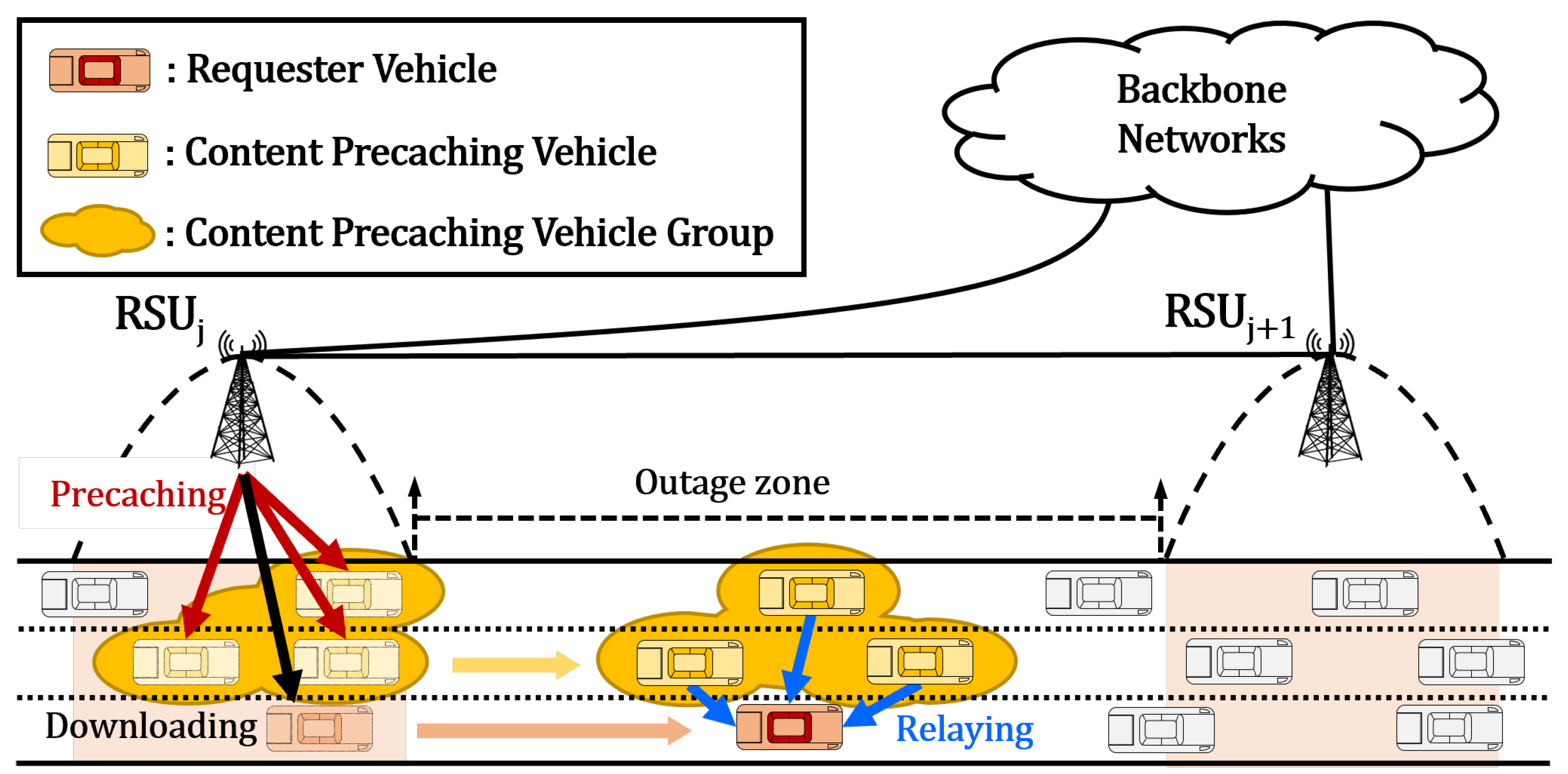
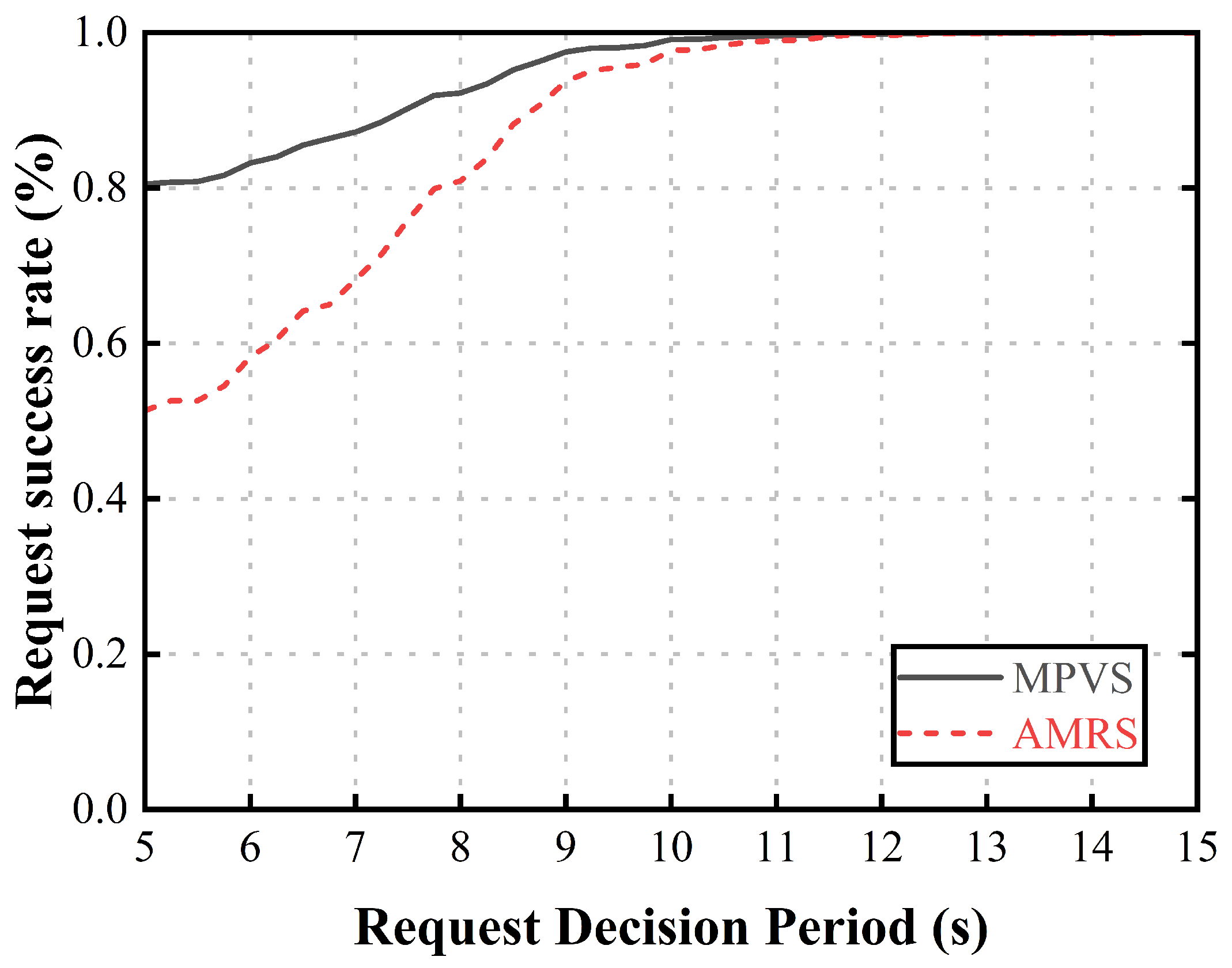
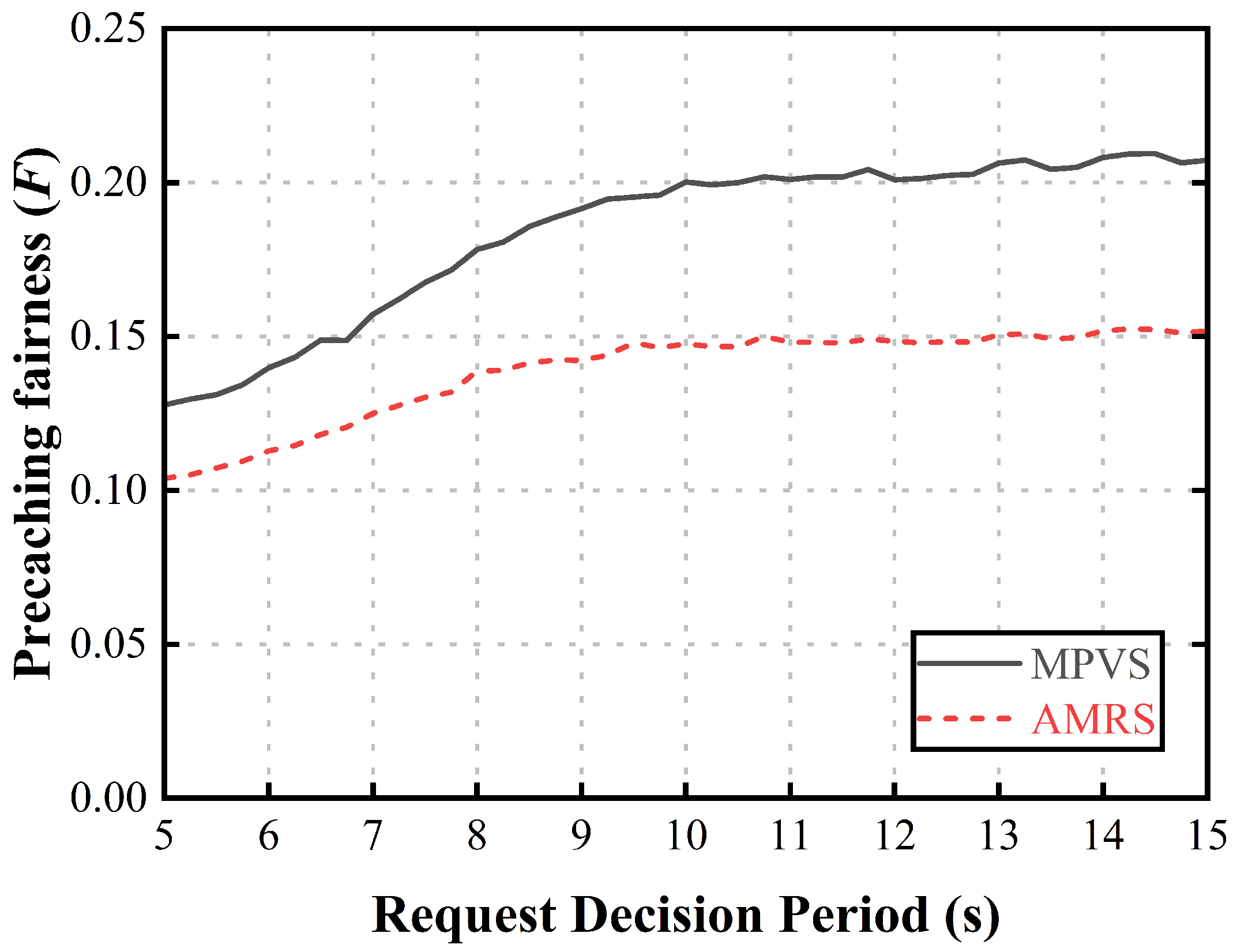

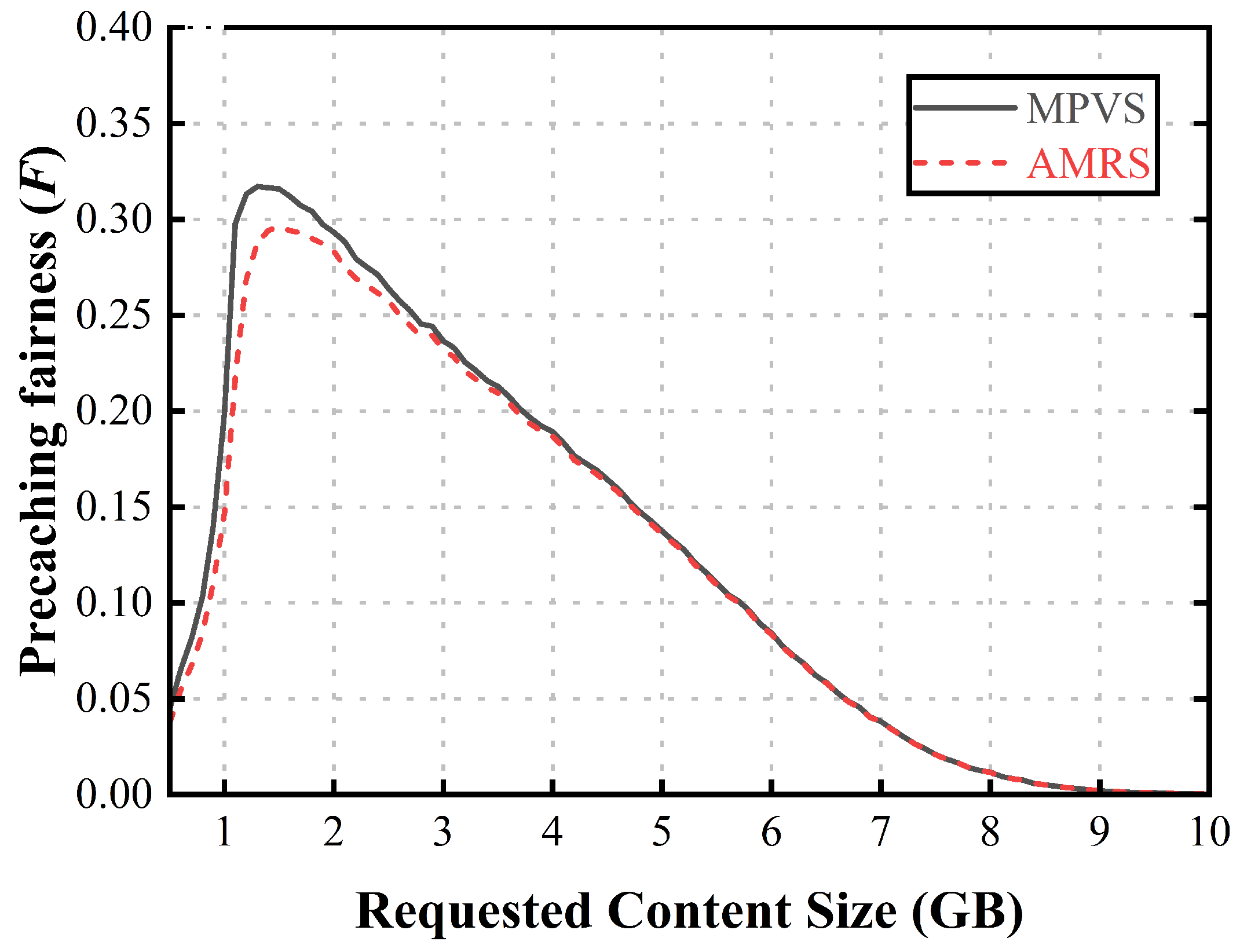
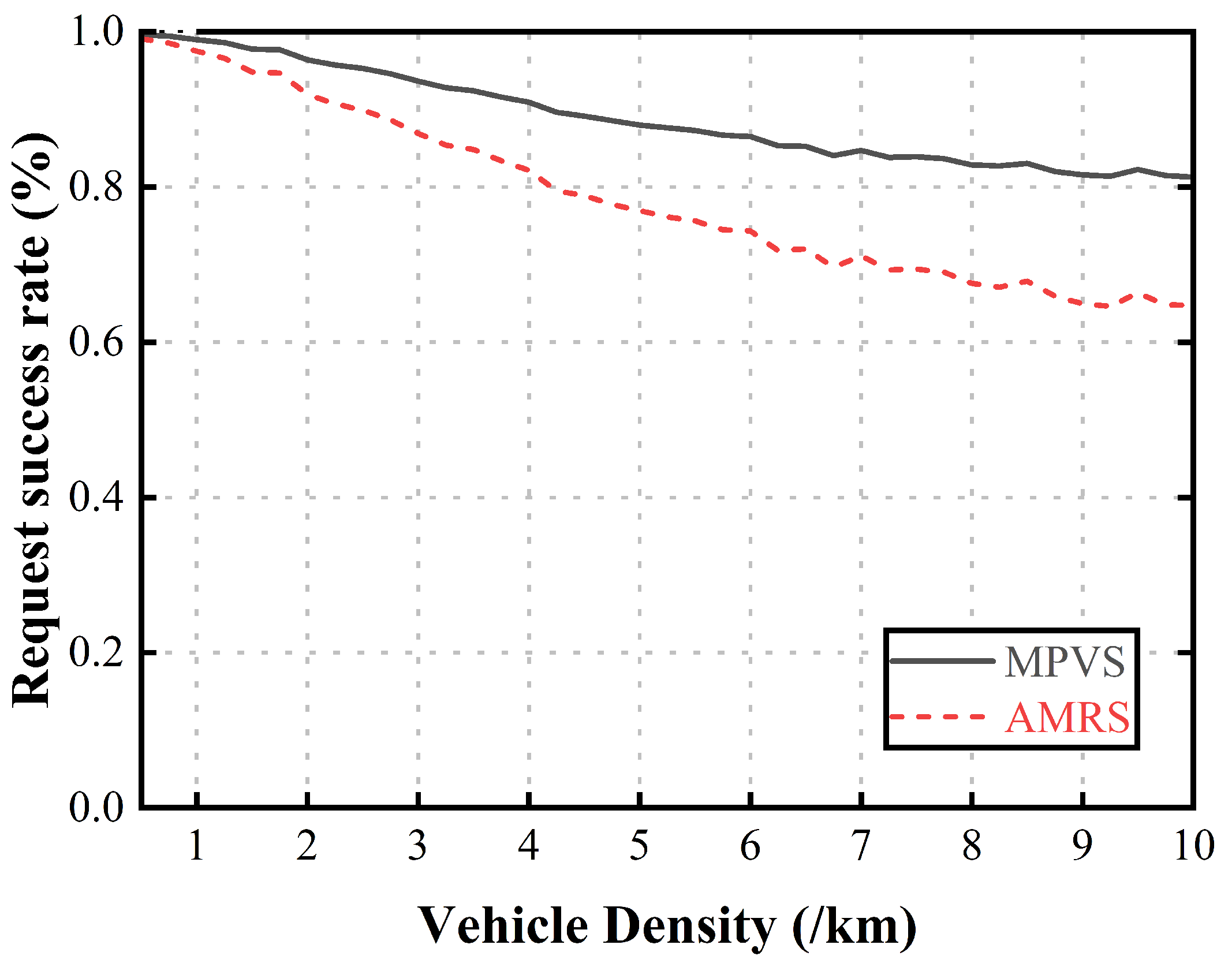
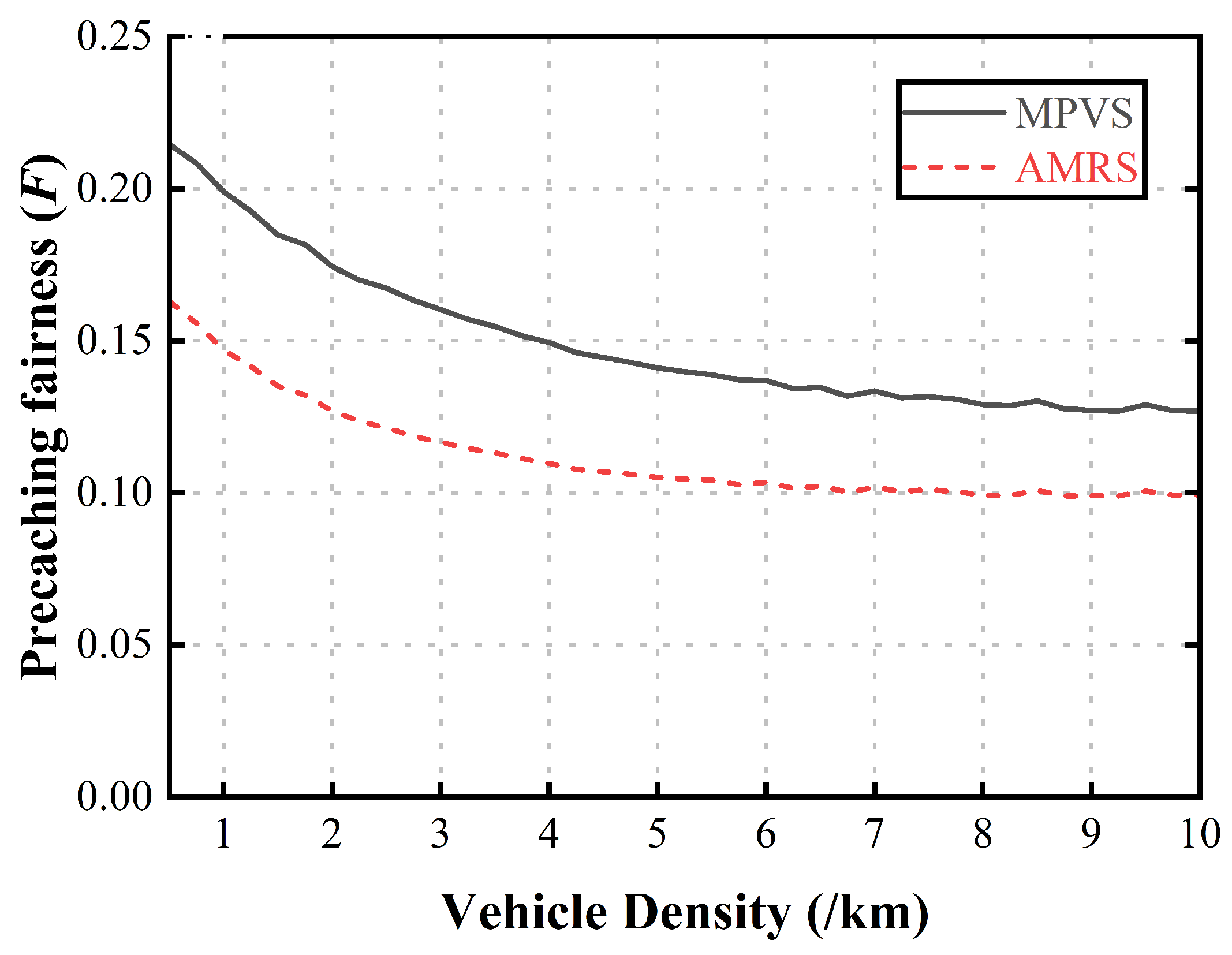
| Notation | Description |
|---|---|
| The j-th RSU, | |
| The i-th vehicle, | |
| The c-th content, | |
| The requester vehicle | |
| The speed of | |
| The transmission rate of I2V | |
| The communication range of the vehicles | |
| The remaining time expected for the requester vehicle to be traveling | |
| within the coverage area of the current RSU | |
| The amount that can download from the current RSU | |
| The total content amount of | |
| The remaining amount of | |
| The downloading time of within the coverage area of the current RSU | |
| The maximum time spent by the requester vehicle within the outage zone | |
| The amount that can be downloaded by within the coverage area of the current RSU | |
| The amount that can be relayed by within the coverage area of the current RSU | |
| The amount that can be precached by | |
| The content-precaching vehicle group | |
| The total available precaching amounts of all vehicles in | |
| The amount precached by | |
| The sets wherein every element has a sufficient | |
| The sets with the minimum number of elements among |
| Parameter | Value |
|---|---|
| Simulation time | 3600 s |
| Network size | 30 km |
| Vehicle mobility model | Highway mobility model |
| Backhaul link latency | 10 ms |
| Backhaul link rate | 10 Gbps |
| Maximum transmission rate of an RSU | 54 Mbps |
| Maximum transmission rate of a vehicle | 54 Mbps |
| An exponent of content popularity | 0.75 |
| RSU transmission range | 1 km |
| Vehicle transmission range | 200 m |
| Vehicle’s CS | 512 GB |
| RSU’s CS | 1 TB |
| Distance between RSUs | 4 km |
| Vehicles’ average speed | 80 km/h |
| Mean of request decision frequency | [5, 15] s |
| Size of requested content | [0.5, 10] GB |
| Vehicle density | [0.5, 10] per km |
Disclaimer/Publisher’s Note: The statements, opinions and data contained in all publications are solely those of the individual author(s) and contributor(s) and not of MDPI and/or the editor(s). MDPI and/or the editor(s) disclaim responsibility for any injury to people or property resulting from any ideas, methods, instructions or products referred to in the content. |
© 2023 by the authors. Licensee MDPI, Basel, Switzerland. This article is an open access article distributed under the terms and conditions of the Creative Commons Attribution (CC BY) license (https://creativecommons.org/licenses/by/4.0/).
Share and Cite
Nam, Y.; Bang, J.; Choi, H.; Shin, Y.; Oh, S.; Lee, E. Multiple Precaching Vehicle Selection Scheme Based on Set Ranking in Intermittently Connected Vehicular Networks. Sensors 2023, 23, 5800. https://doi.org/10.3390/s23135800
Nam Y, Bang J, Choi H, Shin Y, Oh S, Lee E. Multiple Precaching Vehicle Selection Scheme Based on Set Ranking in Intermittently Connected Vehicular Networks. Sensors. 2023; 23(13):5800. https://doi.org/10.3390/s23135800
Chicago/Turabian StyleNam, Youngju, Jaejeong Bang, Hyunseok Choi, Yongje Shin, Seungmin Oh, and Euisin Lee. 2023. "Multiple Precaching Vehicle Selection Scheme Based on Set Ranking in Intermittently Connected Vehicular Networks" Sensors 23, no. 13: 5800. https://doi.org/10.3390/s23135800
APA StyleNam, Y., Bang, J., Choi, H., Shin, Y., Oh, S., & Lee, E. (2023). Multiple Precaching Vehicle Selection Scheme Based on Set Ranking in Intermittently Connected Vehicular Networks. Sensors, 23(13), 5800. https://doi.org/10.3390/s23135800









